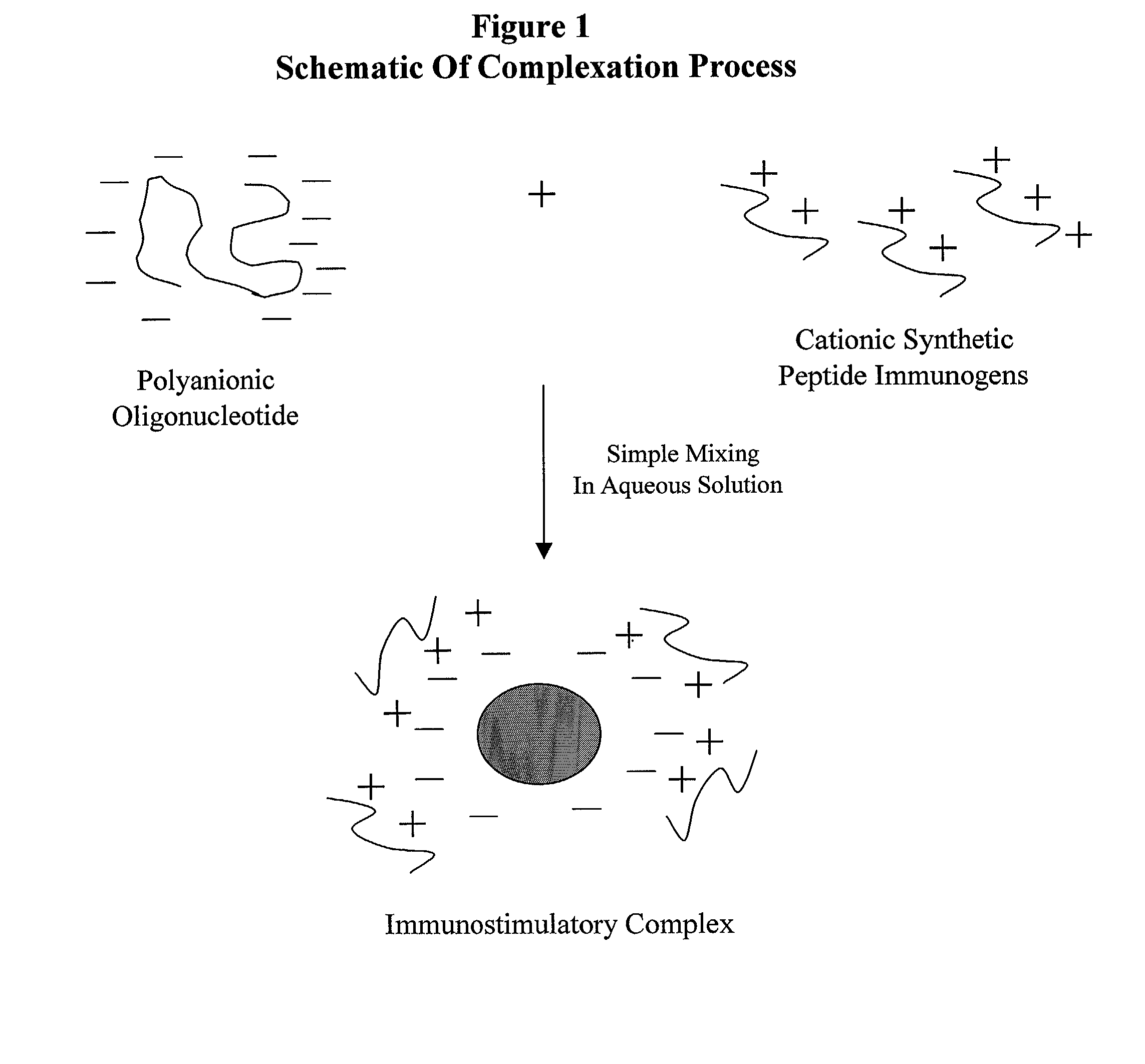Stabilized synthetic immunogen delivery system
a delivery system and synthetic immunogen technology, applied in the direction of aerosol delivery, peptide/protein ingredients, inorganic non-active ingredients, etc., can solve the problems of insufficient immunogens, insufficient adjuvants, and often poorly immunogenic antigens, and achieve the effect of enhancing the physiological properties of synthetic peptide immunogens
- Summary
- Abstract
- Description
- Claims
- Application Information
AI Technical Summary
Benefits of technology
Problems solved by technology
Method used
Image
Examples
example 1
Preparation of Immunostimulatory Complex of LHRH Immunogens and CpG1 Oligonucleotides
[0212]This Example illustrates the preparation of immunostimulatory complex from LHRH peptide immunogens and CpG1 oligonucleotides in various proportions. A flow diagram of the process of complex formation as described herein is shown in FIG. 1.
[0213]All glassware, stir bars and pipette tips were autoclaved for 40 minutes at 121° C. prior to use. All reagents were weighed, dispensed, transferred or added to reaction vessels in a laminar flow hood to prevent contamination.
[0214]An LHRH peptide immunogen stock solution was prepared by mixing a 1:1:1 molar ratio of peptides of SEQ ID NOS: 7-9 at a concentration of 3 mg / mL in distilled deionized water. 33 μL of the stock solution (100 μg of the peptide immunogens) was added to each of a series of 2 mL vials equipped with micro stir bars. To this solution was added 0.5 mL of distilled deionized water as a diluent. A stock solution of 2.0 μg / μL of CpG1 ol...
example 3
Preparation of Dried Immunostimulatory Complex
[0225]This Example illustrates the procedure used to prepare an immunostimulatory complex in a dry state.
[0226]Suspensions of LHRH / CpG1 complexes, prepared as described in Example 1, in 0.5-1.0 mL in aqueous solvent, distilled deionized water, normal saline or phosphate buffered saline, were placed in a dry ice / acetone bath and frozen for 15 minutes. The frozen samples were then placed on a freeze-dryer (Vertis 25LEZ) and the water removed by sublimation at 200 millitorr over three days. This procedure provided a near transparent glassy finished product in the vial. The appearance of the residual solid recovered depends on the aqueous solvent used and can range from a near transparent glass to a white fluffy solid.
[0227]Reconstitution of the dried materials in the same volume of aqueous solvent regenerated a suspension of discrete particles. The particle size distributions, determined as described in Example 2, showed essentially no chan...
example 4a
Preparation of Water-in-Oil Emulsions Using High Shear Homogenization
[0229]This Example illustrates the process of preparing a water-in-oil (w / o)-emulsion from cationic peptides derived from LHRH peptide immunogens (SEQ ID NOS: 7-9 in a 1:1:1 molar ratio in solution), IgE peptide immunogens (SEQ ID NO: 10-11 in a 2:1 molar ratio in solution) CD4 peptide immunogens (SEQ ID No: 4-6 in a 2:1:1 molar ratio in solution) or immunostimulatory complex derived from LHRH, IgE or CD4 immunogens and CpG1 or CpG2 oligonucleotides in various proportions using homogenization techniques. A flow diagram illustrating the process of emulsion formation via homogenization as described herein is shown in FIG. 3.
[0230]All glassware, stir bars and pipette tips were autoclaved for 40 minutes at 121° C. prior to use. All reagents were weighed, dispensed, transferred or added to reaction vessels in a laminar flow hood to prevent contamination.
[0231]The w / o-emulsions were optimized for stability with respect t...
PUM
| Property | Measurement | Unit |
|---|---|---|
| particle size | aaaaa | aaaaa |
| particle size | aaaaa | aaaaa |
| size | aaaaa | aaaaa |
Abstract
Description
Claims
Application Information
 Login to View More
Login to View More - R&D
- Intellectual Property
- Life Sciences
- Materials
- Tech Scout
- Unparalleled Data Quality
- Higher Quality Content
- 60% Fewer Hallucinations
Browse by: Latest US Patents, China's latest patents, Technical Efficacy Thesaurus, Application Domain, Technology Topic, Popular Technical Reports.
© 2025 PatSnap. All rights reserved.Legal|Privacy policy|Modern Slavery Act Transparency Statement|Sitemap|About US| Contact US: help@patsnap.com



